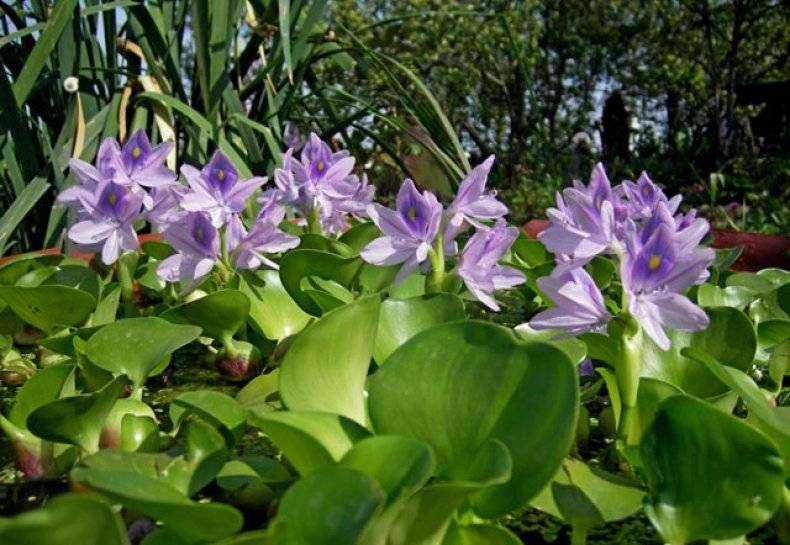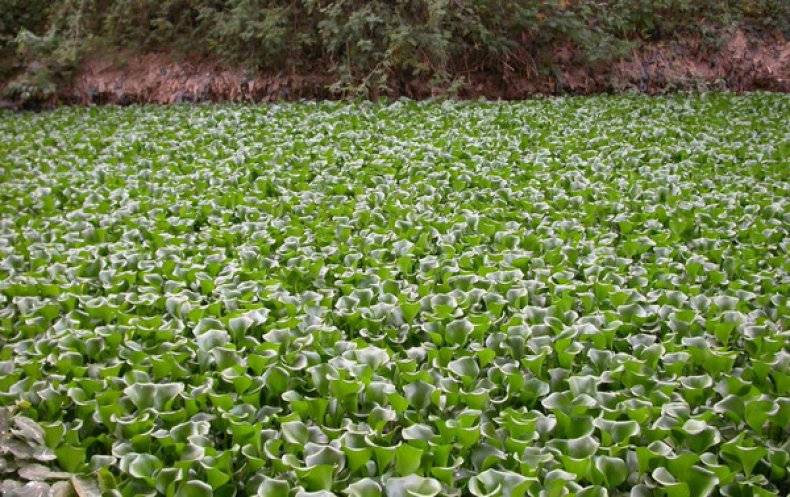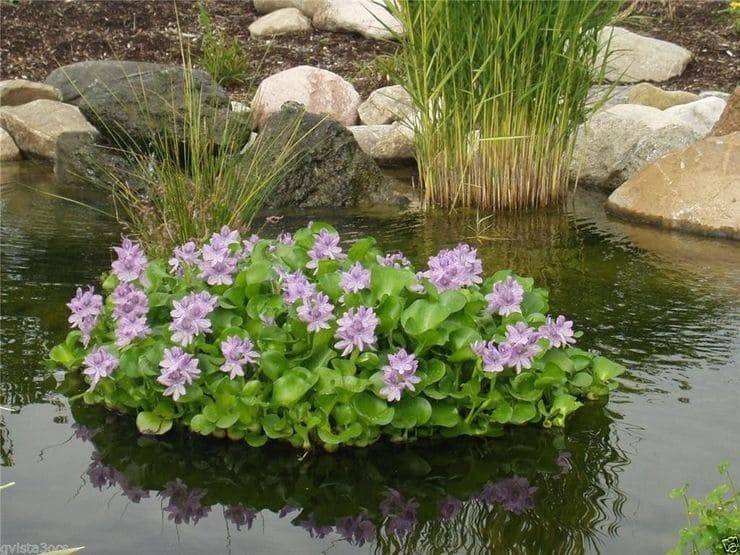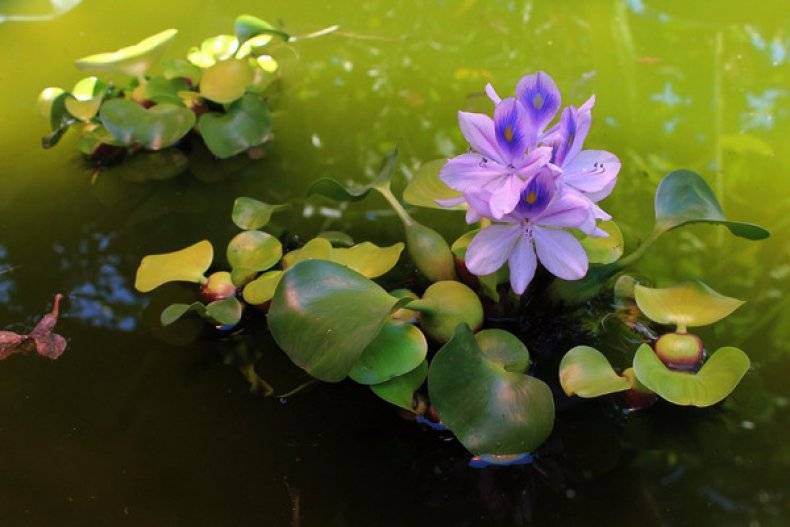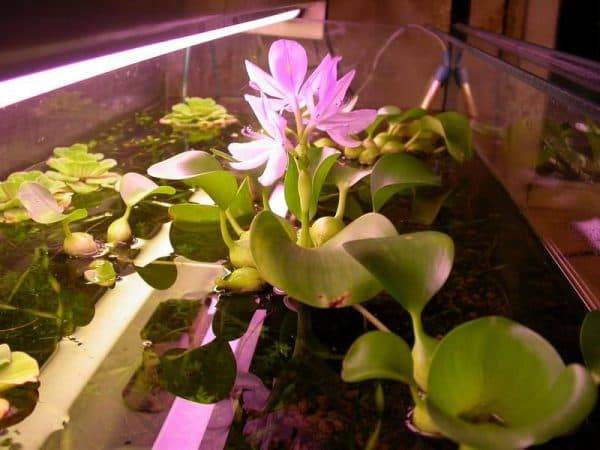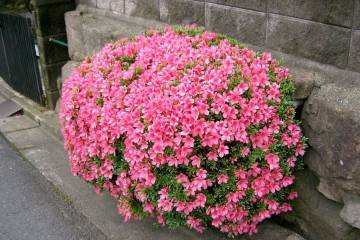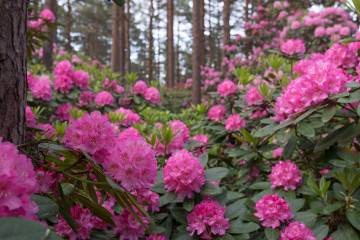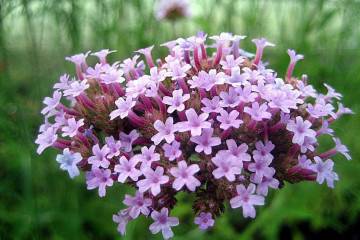Water hyacinth eichornia: planting and care
Content:
Water hyacinth is a beautiful flower that can decorate a pond near your home or in a park. However, in order to grow it, you must carefully follow the rules of care. Delicate flowers and decorative leaves of water hyacinth will be a reward for a florist for his work.
Water hyacinth eichornia: features of the species
Water hyacinth is a plant that grows in water. In the wild, it lives in South America. Its favorite growing places are rivers and lakes. This plant is very viable and in favorable conditions is able to completely occupy the surface of the reservoir.
In the water hyacinth eichornia, the leaves are rounded. Their diameter is 20 cm. The leaves are collected in rosettes and grow in such a way that they remain on the surface of the reservoir all the time. The stem grows up to 15 cm in height. In the wild, it sometimes reaches 1 m. The size of the flowers is 3 cm in diameter. The color of the buds is from thick lilac to pale pink. They have a characteristic fragrant aroma. Flowering occurs throughout the spring and summer.
This plant has the ability to purify water where it grows. This is one of the reasons why it is used to decorate aquariums. It is able to absorb fish waste products, heavy metals, pollution, and removes an unpleasant odor.
This plant is used not only for landscaping or aquariums. In his homeland, both lettuce and organic fuel are grown.
When water hyacinth blooms in nature
In the wild, flowers grow at 26 ° C. Flowering time is highly dependent on temperature. As soon as it exceeds 28 ° C, the hyacinth blooms. Flowering lasts until it drops to 22 ° C.
Therefore, you can count on flowering in those regions of the country where the southern or temperate climate. In more northern regions, you should not count on annual flowering.
Water hyacinths and landscaping
This plant can decorate any body of water. Its decorative leaves and delicate blossoms will create a special atmosphere. However, it must be remembered that the rapid growth of the water hyacinth creates difficulties for the inhabitants of the reservoir. In particular, the green carpet prevents sufficient oxygen from entering the water. Therefore, while enjoying the beauty of a water hyacinth, you must remember to care for it in such a way as to limit its attempts to grow.
Breeding features
At home, it is possible to create conditions for the reproduction of a water hyacinth. For this, processes are used that are formed during the growth process. This plant can reproduce vegetatively, and this happens at an impressive rate. In one month, you can get up to 100 copies.
Landing
Planting and caring for a water hyacinth in a pond should be carried out as follows.
Before planting, the reservoir does not need to be cleaned. This is due to the fact that the plant is able to independently purify water. Water that has slightly acidic reactions is best suited.
When growing hyacinth for an aquarium, there are additional features. Under these conditions, it is easier to provide suitable temperature conditions. However, the volume of the aquarium should be large enough for the hyacinth to have enough room for full development. It is also important to provide high quality and abundant lighting for the plant.
Pond and indoor care
When growing, it is important to create conditions that will be as close as possible to the natural habitat. It is more difficult to grow hyacinth for a pond than for a home aquarium.
The plant does not tolerate drafts and strong winds. Therefore, when grown in a pond, shrubs or flowers must be planted next to it to protect from the wind. Usually marsh iris or cattail are used for this purpose.
Lighting
Hyacinth likes abundant lighting. In order for it to develop well and bloom magnificently, it is necessary to make sure that the flower receives as much sunlight as possible.
Temperature
When growing, it is important to provide a suitable water temperature. For a hyacinth, it should be in the range of 24-30 ° C.
This plant is very sensitive to sudden temperature changes, therefore it is necessary to provide it with such conditions in which the temperature will be stable.
Pruning
The flower needs regular pruning. This is especially important to keep in mind when using it in an aquarium, as it regularly sprouts there. So that it does not completely occupy the entire water surface, they must be cut off, preventing them from spreading further than necessary.
It is also necessary to do pruning in the fall. At this time, you need to remove dead leaves. They can be easily distinguished as they take on an unnatural black color.
Fertilizers for hyacinth in the pond
For growing hyacinth, water is suitable, which is rich in nutrients. Additionally, it is recommended to add bottom silt, humus or compost to it.
Wintering plants
This plant does not tolerate strong changes in temperature and lighting very badly, so the onset of winter is a great stress for it.
Silt storage
When using this method, it is necessary to prepare a deep pot and fill it with silt from the reservoir in which the flower is located. It is necessary to fill the sludge with water so that there is 3-5 cm of liquid above it. The hyacinth pot must be placed on the windowsill for storage.
Sand storage
You can keep the hyacinth in wet sand. This can be done at room temperature.
Overwintering at the bank
As soon as the temperature outside reaches 15 ° C, you need to place the flower in a jar with its usual water and transfer it to a warm room. During the entire winter period, it is necessary that the daylight hours be at least 10 hours during each day.
It is necessary to regularly measure the temperature at which the flower is kept. It is necessary that it does not fall below 20 ° C.
The presence of drafts in this place is unacceptable.It is necessary to humidify the air.
The plant can be placed on a ring float to facilitate its living conditions. It is necessary to feed the hyacinth throughout the winter. When the warm time comes again, the flower will need to be transplanted into the pond.
In a home aquarium
To make it easy for your water hyacinth to survive the winter, you can use an aquarium. To do this, you need to do the following:
- Fill the aquarium with water. It is necessary to take the one in which the flower grew in the pond. If this is not possible, it is allowed to use settled water.
- At the bottom of the tank, you need to make a layer of silt from the reservoir native to the hyacinth.
- The water must be saturated with a suitable feeding. For this purpose, for example, you can use fertilizer for home aquarium plants.
- You can keep a flower in an apartment during the winter at normal room temperature.
- It is necessary to provide the usual lighting regime for the hyacinth. To do this, it is advisable to put the aquarium on a windowsill so that the plant gets a natural sunny color. It is necessary that daylight hours have a duration of at least 10 hours. This will require the organization of artificial lighting.
Water hyacinth requires careful maintenance. If done correctly, this beautiful plant will delight the grower for many years.
